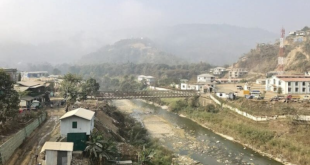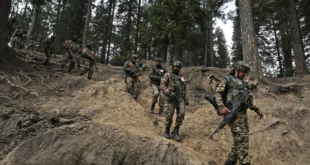Russia and India extended a program for military and technical cooperation lasting until 2031 and signed a slew of bilateral defense agreements, including a deal for the production of assault rifles, during President Vladimir Putin’s visit to New Delhi on December 6.
In addition, the two countries are planning long-term cooperation on coal, shipbuilding, fertilizer, steel, and skilled labor, India’s foreign secretary said after the meeting in New Delhi.
Harsh Vardhan Shringl said that Putin and Prime Minister Narendra Modi also expressed interest in furthering oil and gas investments in each other’s countries, agreed on the need to strengthen the Paris-based Financial Action Task Force (FATF), and discussed extending maritime cooperation in the Indian Ocean.
The agreement for the manufacture of Kalashnikov assault rifles at a factory in India’s Uttar Pradesh through a joint venture was one of the pacts signed during a meeting of the Inter-Governmental Commission on Military and Military-Technical Cooperation, a Defense Ministry spokesman said. India will produce more than 600,000 AK-203s under the deal.
Another pact signed during the meeting led by Russian Defense Minister Sergei Shoigu and Indian Defense Minister Rajnath Singh was a program for military technical cooperation from 2021 to 2031, which extends an existing protocol.
On COVID-19, Shringl said the two leaders agreed on the need for multilateral framework to manage the pandemic.
Russian Foreign Minister Sergei Lavrov announced ahead of the summit that an agreement to supply India with S-400 air-defense missile systems would go ahead despite what he described as efforts by the United States to undermine the deal.
India has begun taking deliveries of the advanced Russian system under a $5.4 billion deal signed by Putin during a visit to India in 2018, potentially putting New Delhi in the crosshairs of U.S. sanctions.
“The S-400 deal is not only symbolic, but also pragmatically significant for ensuring India’s defense potential,” Lavrov said after negotiations with Indian counterpart Subrahmanyam Jaishankar.
Lavrov also told journalists that the two sides agreed that the Taliban, which retook control of Afghanistan in August, must live up to its pledges to have an inclusive and ethnically and political mixed government, safeguard human rights, and prevent any terrorist and drug trafficking threats on Afghan soil.
The Russian foreign minister added that Moscow saw benefits to India and Iran joining the so-called extended Troika on Afghanistan, which currently includes Russia, the United States, China, and Pakistan.
Putin’s visit to India marks only his second trip outside Russia since the coronavirus pandemic, after a June summit in Geneva with U.S. President Joe Biden.
Putin’s deal for Russia to deliver S-400 systems has attracted controversy going into the talks.
A similar purchase by NATO ally Turkey led to U.S. sanctions and Ankara’s removal from the F-35 fighter jet program under the Countering America’s Adversaries Through Sanctions Act (CAATSA).
The United States hasn’t decided whether to grant India a waiver for Russian arms purchases under CAATSA, State Department spokesperson Ned Price told reporters on November 23.
Conversations with India are ongoing “in the context of a defense relationship that is meaningful to us, that is important both to the United States and India, including in the context of a free and open Indo-Pacific,” Price said.
India appears to believe it will be granted a waiver as it expands ties with the United States with the aim of countering China.
Junior Defense Minister Ajay Bhatt told parliament last week that the government was aware of potential U.S. action but will make “sovereign decisions” based on the country’s defense needs.
“The S-400 is a potent system in terms of its operational capability to provide a continuous and effective air defense system to a very large area,” Bhatt said. “With the induction of this system, [the] air defense capability of the nation will be significantly enhanced.”
The world’s largest democracy is a member of the Quad group with United States, Japan, and Australia that is emerging as a bloc to contain Chinese influence in the Indo-Pacific region, making New Delhi a key partner for Washington.
India views China as one of its biggest security threats and the two nuclear-armed powers skirmished along their disputed Himalayan border in 2020, leading to dozens of casualties on both sides amid an ongoing standoff.
India plans to place the S-400s in the northwest of the country, near the disputed borders with China and rival nuclear power Pakistan. The S-400s will be operational early next year and expanded as the system is progressively delivered by 2023, The Times of India reported.
Russia is India’s largest weapons supplier, accounting for 23 percent of Moscow’s global arms exports between 2016 and 2020, according to the Stockholm International Peace Research Institute (SIPRI).
But the share of India’s arms purchases from Russia has fallen from 70 to 49 percent between the period 2011 and 2015 as well as between 2016 and 2020, according to SIPRI. The drop comes as New Delhi seeks to modernize and diversity away from Soviet-era and Russian military equipment by expanding defense purchases from France, Israel, and the United States.
 Eurasia Press & News
Eurasia Press & News



